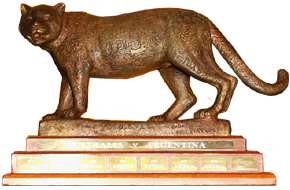
Argentina is divided into twenty-three federated states called provinces and one called the autonomous city of Buenos Aires, which is the federal capital of the republic as decided by the Argentine Congress. The provinces and the capital have their own constitutions and exist under a federal system.

Ushuaia – Malvinas Argentinas International Airport is located 4 km (2.5 mi) south of the center of Ushuaia, a city on the island of Tierra del Fuego in the Tierra del Fuego Province of Argentina.

Argentine Peak is a high mountain summit in the Front Range of the Rocky Mountains of North America. The 13,743-foot (4,189 m) thirteener is located in Arapaho National Forest, 8.5 miles (13.6 km) southwest by south of Georgetown, Colorado, United States. The summit lies on the Continental Divide between Clear Creek and Summit counties.
The Kirin Cup Soccer is an association football tournament organised in Japan by the Kirin Brewery Company. The host, Japan, is a participant in every edition. The tournament was founded in 1978 then known as Japan Cup, and was last held in its full form in 2022. From 1992 onwards, the format was changed to a round robin national team competition. The first nation to win the competition was Argentina. Japan are the tournament's most successful team with eleven titles, followed by Peru with three titles. As of 2022, the current cup holders are Tunisia.

The Puma Trophy is an international rugby union competition between Argentina and Australia. The trophy is a bronzed statue of a puma. Argentina and Australia first played against each other in 1979 and the trophy itself was established in 2000.

Thoatherium is an extinct genus of litoptern mammals from the Early Miocene of Argentina. Fossils of the genus have been found in the Santa Cruz Formation in Argentina.

Provoleta is an Argentine variant of provolone cheese described as "Argentine pulled-curd provolone cheese". It can be heated on a grill, or indoors in a cast-iron pan. The cheese is firm and can hold its shape when grilled.
Argentine Americans are Americans whose full or partial origin hails from Argentina.

Formosa International Airport, also known as El Pucú Airport, is an international airport serving Formosa, Argentina, a city on the Paraguay River, which is locally the border between Argentina and Paraguay. The airport is operated by Aeropuertos Argentina 2000.

Argentina–Japan relations were established in the late 19th century. Argentina maintains an embassy in Tokyo and Japan maintains an embassy in Buenos Aires.

Argentina, officially the Argentine Republic, is a country in the southern half of South America. Argentina covers an area of 2,780,400 km2 (1,073,500 sq mi), making it the second-largest country in South America after Brazil, the fourth-largest country in the Americas, and the eighth-largest country in the world. It shares the bulk of the Southern Cone with Chile to the west, and is also bordered by Bolivia and Paraguay to the north, Brazil to the northeast, Uruguay and the South Atlantic Ocean to the east, and the Drake Passage to the south. Argentina is a federal state subdivided into twenty-three provinces, and one autonomous city, which is the federal capital and largest city of the nation, Buenos Aires. The provinces and the capital have their own constitutions, but exist under a federal system. Argentina claims sovereignty over the Falkland Islands, South Georgia and the South Sandwich Islands, the Southern Patagonian Ice Field, and a part of Antarctica.
The Military ranks of Argentina are the military insignia used by the Armed Forces of the Argentine Republic.

Argentina Glacier is a glacier flowing northwest from Hurd Dome and terminating near Argentina Cove, South Bay, on Livingston Island, in the South Shetland Islands. The name Argentina Glacier was given in association with Argentina Cove by the Spanish Antarctic Expedition, about 1995.

Indian Argentines, also known as Indo-Argentines, are Argentines who have predominantly or total Indian ancestry. There is a small community of Indians in Argentina who are mainly immigrants from India and the neighboring countries in South America and the Caribbean with Indo-Caribbean influence and some of whom were born in Argentina and are of Indian heritage, related to the Indo-Aryan and Dravidian peoples, so the term can also include descendants of Pakistanis, Nepalis, Bengalis and Sinhalese.
Griphotherion is an extinct genus of notoungulate mammal from the Eocene of Argentina. A fossil skeleton was found in the Lumbrera Formation and described in 2011 as the holotype of the type species G. peiranoi.

Quetecsaurus is a genus of titanosaurian sauropod dinosaur known from the Late Cretaceous of the southern Mendoza Province, western Argentina. It contains a single species, Quetecsaurus rusconii.

The Serbian Orthodox Eparchy of Buenos Aires, South and Central America is a Serbian Orthodox Church eparchy (diocese) with the main headquarters located in the city of Buenos Aires, Argentina. The diocese has 20 churches in Argentina, Brazil, Chile, Dominican Republic, Venezuela, Ecuador, El Salvador, Colombia and Peru. On October 13, 2012, was realized the first session of diocese under the rule of the actual administration of Metropolitan bishop Amfilohije Radović. The decision of the Holy Assembly of Bishops of the Serbian Orthodox Church brought in May 2018 elected Kirilo Bojović the first Serbian Bishop of Buenos Aires and South-Central America. He was enthroned in the Cathedral church of Nativity of Virgin in Buenos Aires, Argentina, on 4 September 2018.

Polydolopimorphia is an extinct order of metatherians, closely related to extant marsupials. Known from the Paleocene-Pliocene of South America and the Eocene of Antarctica, they were a diverse group during the Paleogene, filling many niches, before declining and becoming extinct at the end of the Neogene. It is divided into two suborders, Bonapartheriiformes, and Polydolopiformes Most members are only known from jaw fragments, which have their characteristically generally bunodont teeth. The morphology of their teeth has led to proposals that polydolopimorphians may be crown group marsupials, nested within Australidelphia, though this proposal, has been questioned, with other analyses finding them outside of crown-group Marsupialia. The monophyly of the group has been questioned, due to the possibility of the characteristic bunodont teeth emerging convergently in unrelated groups, rather than reflecting a true phylogenetic relationship. The group contained omnivorous, frugivorous and herbivorous forms.

This article presents official statistics gathered during the COVID-19 pandemic in Argentina. The National Ministry of Health publishes official numbers every night.



















